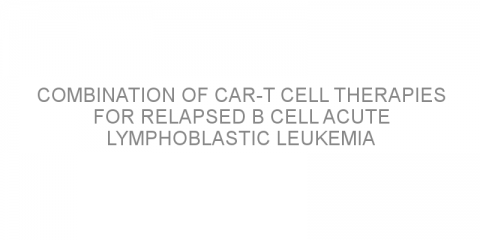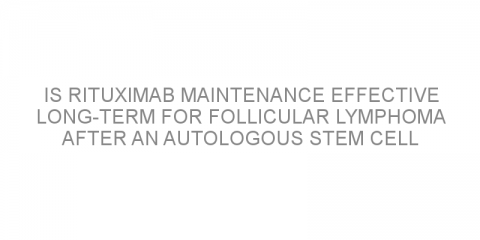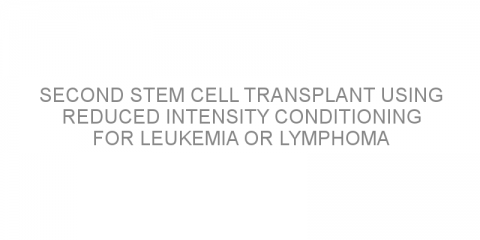In a nutshell This study aimed to compare outcomes of donor types for a second allogeneic stem cell transplant (alloSCT) in patients with relapsed acute lymphoblastic leukemia (ALL). This study concluded that there is no major difference in overall survival between a matched unrelated donor (MUD) and a half-matched donor (HMD) in...
Read MoreTreatment(s) already received-Bone marrow transplant Posts on Medivizor
Combination of CAR-T cell therapies for relapsed B cell acute lymphoblastic leukemia
In a nutshell This study aimed to investigate if combined CD19 and CD22 chimeric antigen receptor (CAR) T-cell therapies could be used to treat patients with relapsed acute lymphoblastic leukemia (ALL) after transplant. This study concluded that this combination improved long-term survival for these patients. Some...
Read MoreIs rituximab maintenance effective long-term for follicular lymphoma after an autologous stem cell transplant?
In a nutshell The authors reviewed rituximab (Rituxan) maintenance (RM) therapy in patients with relapsed follicular lymphoma (FL) treated with an autologous stem cell transplant (ASCT). The study found that RM after ASCT delayed FL relapse after a 12-year follow up. Some background Rituximab and chemotherapy have improved the outcomes of...
Read MoreSecond stem cell transplant using reduced intensity conditioning for leukemia or lymphoma
In a nutshell This study aimed to investigate the outcomes of a second hematopoietic stem cell transplant (HSCT) after reduced-intensity conditioning (RIC) for patients with leukemia or lymphoma. This study concluded that this treatment path is feasible and a good treatment alternative for these patients. Some background Allogenic...
Read MoreSecond stem cell transplant using reduced intensity conditioning for leukemia or lymphoma
In a nutshell This study aimed to investigate the outcomes of a second hematopoietic stem cell transplant (HSCT) after reduced-intensity conditioning (RIC) for patients with leukemia or lymphoma. This study concluded that this treatment path is feasible and a good treatment alternative for these patients. Some background...
Read MoreTreating acute myeloid leukemia with FLT3-ITD mutation by sorafenib maintenance after HSCT
In a nutshell The study evaluated outcomes of sorafenib (Nexavar) maintenance therapy after allogeneic hematopoietic stem cell transplantation (alloHSCT) in patients with acute myeloid leukemia (AML) carrying FLT3-ITD mutation. The authors found that sorafenib maintenance therapy decreased the risks of relapse and mortality after HSCT in such...
Read MoreThe effects of a second autologous stem cell transplantation in patients with relapsed/refractory Hodgkin lymphoma after a first transplant
In a nutshell The study evaluated the outcomes of second autologous stem cell transplantation (ASCT2) in patients with relapsed/refractory Hodgkin lymphoma (r/r-HL) after a first transplantation (ASCT1). The main finding was that ASCT2 was safe and relatively effective in such patients. Some background ASCT replaces cancerous bone marrow with healthy...
Read MoreEvaluating cyclophosphamide in patients with acute myeloid leukemia receiving donor transplants
In a nutshell This study aimed to investigate post-transplant cyclophosphamide treatment in patients with acute myeloid leukemia. This study concluded that this treatment is safe and effective in these patients. Some background Post-transplant cyclophosphamide (PTCy) is an immune system suppressant. It can be used after...
Read MoreDo stem cell transplants improve patients’ long-term survival?
In a nutshell This study examined the long-term survival of patients who received stem cell transplants (SCT) and compared them to the general population. The authors found that patients who received SCTs had almost the same chance of survival as the general population and identified factors that alter this chance. Some background Treatments such as...
Read MoreDo stem cell transplants improve patients’ long-term survival?
In a nutshell This study examined the long-term survival of patients who received stem cell transplants (SCT) and compared them to the general population. The authors found that patients who received SCTs had almost the same chance of survival as the general population and identified factors that alter this chance. Some background Treatments such as...
Read MoreDo stem cell transplants improve patients’ long-term survival?
In a nutshell This study examined the long-term survival of patients who received stem cell transplants (SCT) and compared them to the general population. The authors found that patients who received SCTs had almost the same chance of survival as the general population and identified factors that alter this chance. Some background Treatments such as...
Read MoreDo stem cell transplants improve patients’ long-term survival?
In a nutshell This study examined the long-term survival of patients who received stem cell transplants (SCT) and compared them to the general population. The authors found that patients who received SCTs had almost the same chance of survival as the general population and identified factors that alter this chance. Some background Treatments such as...
Read More











